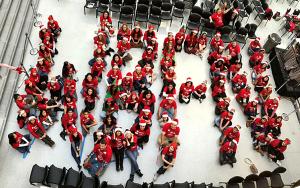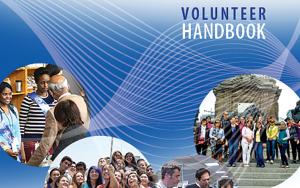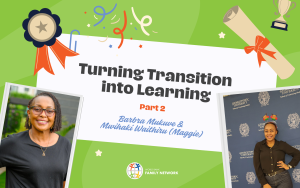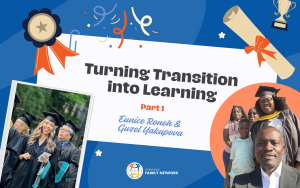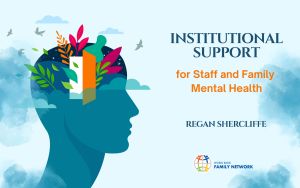
A regular day at the WBGFN office: English classes in session, conversations and interactions; only, it was eighteen months ago. Little did anybody know that we were about to venture into the unknown world of online teaching, a world vastly different from what any instructors or students had experienced before. We talked to our WBGFN English Program teachers, Alex Alba and Carmela Cosans, to learn about their firsthand experience pivoting to this uncharted terrain.
Please describe your experience delivering an in-person learning program until abruptly faced with the unprecedented pandemic lockdown.
CARMELA: It was March 2020 and we were halfway through our WBGFN English program when suddenly the COVID-19 crisis became a blaring reality. The lockdown necessitated a transition to a virtual classroom via the ZOOM online platform. The in-person interaction of in-class sessions would now be redefined. Teaching and learning would need to adapt to the new technology.
ALEX: One of the great pleasures of teaching the spouses and partners of the World Bank staff is watching the bonds and friendships that develop between them. When students from different cultural and language backgrounds dedicate hours, every week discussing challenging topics, studying in small groups, doing activities and giving presentations, a truly wonderful dynamic begins to develop. When I see the students start to joke with each other, or support each other when struggling, and when I hear they have begun to meet each other outside class, I feel a special kind of fulfillment as a teacher because I know their relocation will be easier and more enjoyable with these new connections and friendships.
Did this happen when classes switched online? I would say that in part it did, but not to the same extent. It seems that being physically present with each other is an important part of building intimacy. Another restriction was Covid itself, because even if the students had been tempted to meet outside class, of course, no one could.
Please describe your experience immediately moving the class online.
ALEX: The mechanics of teaching on Zoom went smoothly once I figured out the best ways to share material (with lots of help from my tech-savvy students). Additionally, the Breakout rooms are a vital tool to give the students the opportunity to talk and work with each other. If not, on Zoom they are always facing me, only being able to talk one at a time, which is too formal and teacher-centered for natural language learning.
What we gained being online were students from different locations. I had a student in Ecuador and several in France, one of whom moved to Egypt. So, while we were physically confined to our houses, there was a sense of reaching out to people across the world, and of being part of a large, borderless community, which was important to us psychologically during the pandemic. We could also share our stories of the crisis, hearing how it was playing out in real time in different countries.
CARMELA: As instructors, we modified and adjusted our curriculum while our students navigated the challenges of the new technology. There was the occasional connectivity problem and the management of home distractions; the barking dog or crying child. Students quickly learned to mute their computers while they politely disappeared for a moment to address issues. With this backdrop, we continued to navigate our way through English grammar points, presentations and new vocabulary.
The new virtual platform and the lockdown restrictions meant we could no longer linger over coffee during breaks or enjoy casual discussions over lunch in the cafeteria. Our museum visits, always a great occasion to practice English, could no longer take place as museums closed their doors. These very important immersive, culturally rich activities, necessary to language acquisition and fluency, were put on hold. Despite these drawbacks and inconveniences, my students began to enjoy some of the benefits of virtual learning. Students now had additional time; for many, a time-wasting commute into the city was eliminated. Young mothers who no longer needed to dash back home to pick up children from daycare were relieved.
As we adjusted to the ZOOM platform, we became comfortable with mute buttons, breakout rooms (if needed), screen-sharing and presentations. We were also able to welcome students from the World Bank community who lived abroad. The younger students took comfortably to virtual learning but acknowledged the desire to meet face-to-face.
Please share your thoughts on how the participants of the program grew together as a community during the pandemic.
ALEX: The pandemic has been such a difficult time for all of us. I will never forget the concern we all had when one of my students caught Covid, and when another told us her parents had it. One student was a pharmacist who could not work at her profession in the US, but instead began to volunteer giving vaccines when they first came out. I could see her satisfaction that finally she was able to contribute some of her skills to the crisis.
Transitioning to Zoom classes during a pandemic hasn’t been ideal, but the students bring such good will, humor and optimism to our sessions, that I feel it more than makes up for the limitations of the remote classroom.
Please share your thoughts on the future of the WBGFN English Program.
CARMELA: As we prepare for a new session of online learning, the pandemic still haunts our lives. Whatever the future holds, one thing is certain, language learning will continue. Instructors and students are demonstrating flexibility, resilience, adaptability and above all, creativity, in their desire to continue language learning. We all understand that whether we meet in a real or virtual classroom, we must find new ways to motivate ourselves. The success of learning a new language will always be closely aligned to the way students and instructors engage with each other. Gaining proficiency in the new language will require immersion and real world interaction. As we look to the future, English learning will likely involve a hybrid of online and in class instruction.
While the pandemic closed the door to in-person teaching at WBGFN, a new window of well-planned online classes charted the way to this novel remote experience.

